The Cognitive Computing Market is estimated to be valued at USD 28.8 billion in 2025 and is projected to reach USD 270.7 billion by 2035, registering a compound annual growth rate (CAGR) of 25.1% over the forecast period.
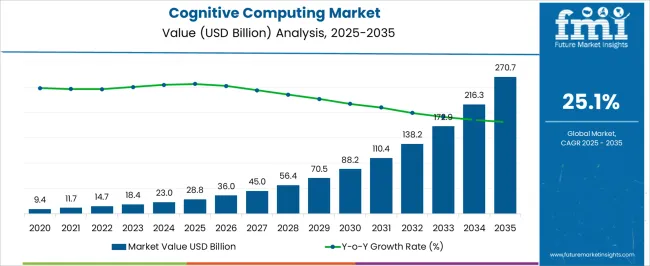
| Metric | Value |
|---|---|
| Cognitive Computing Market Estimated Value in (2025 E) | USD 28.8 billion |
| Cognitive Computing Market Forecast Value in (2035 F) | USD 270.7 billion |
| Forecast CAGR (2025 to 2035) | 25.1% |
The cognitive computing market is expanding rapidly due to increasing adoption of artificial intelligence and machine learning technologies across diverse industries. The demand for advanced decision making tools, natural language processing, and predictive analytics is driving large scale implementation in enterprise systems.
Heightened focus on personalized user experiences, real time data processing, and improved operational efficiency is further accelerating adoption. Regulatory frameworks emphasizing data compliance and security have also encouraged enterprises to integrate cognitive platforms with robust security architectures.
Advancements in cloud infrastructure and hybrid deployment models are supporting flexible implementation strategies. The market outlook remains strong as organizations continue to leverage cognitive computing to enhance diagnostics, optimize workflows, and strengthen business intelligence in highly competitive environments.
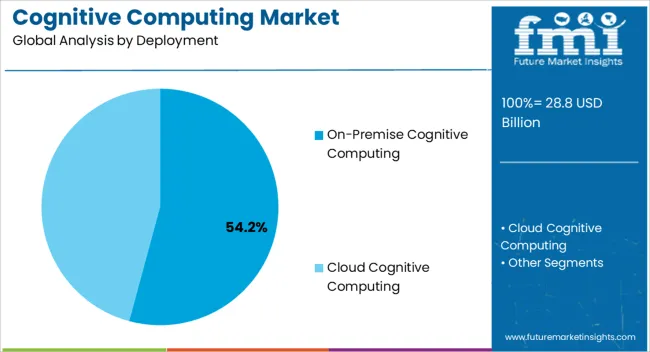
The on premise cognitive computing deployment segment is expected to account for 54.20% of the total market by 2025, making it the most dominant deployment category. Its leadership is supported by demand from organizations that prioritize security, compliance, and complete control over data infrastructure.
Enterprises in regulated sectors such as finance, defense, and healthcare prefer on premise solutions to safeguard sensitive data while maintaining seamless integration with existing legacy systems. Higher upfront costs have been justified by long term benefits in performance reliability and customization flexibility.
This preference has strengthened the position of on premise cognitive computing as the leading deployment model.
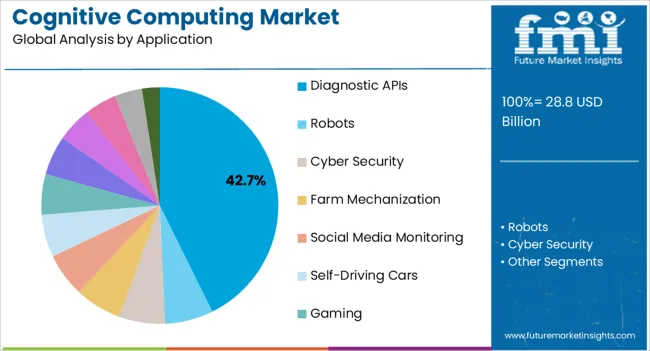
The diagnostic APIs application segment is projected to represent 42.70% of the overall market by 2025, positioning it as the most prominent application. Growth is being driven by the need for advanced diagnostic support tools, integration with electronic health records, and real time clinical decision assistance.
Diagnostic APIs are enabling faster interpretation of complex datasets and are widely adopted in healthcare and life sciences for predictive modeling and patient outcome optimization. The ability to reduce diagnostic errors, support remote patient care, and deliver actionable insights has reinforced their demand.
These benefits continue to strengthen their role as the leading application area in cognitive computing.
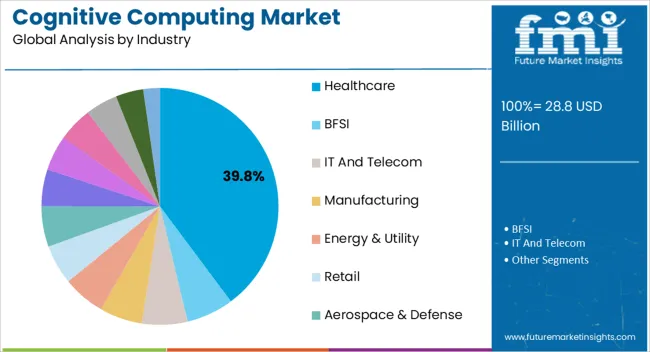
The healthcare segment is expected to capture 39.80% of total market revenue by 2025 within the industry category, making it the largest contributor. This growth is being propelled by rising investments in AI enabled healthcare solutions, the need for accurate diagnostics, and demand for efficient patient management systems.
Hospitals and clinics are deploying cognitive computing platforms to analyze medical imaging, streamline administrative workflows, and personalize treatment plans. Growing emphasis on telemedicine and remote care has also encouraged adoption.
Furthermore, healthcare providers are leveraging cognitive tools to improve drug discovery, reduce costs, and enhance clinical outcomes. As a result, healthcare continues to dominate as the leading industry for cognitive computing adoption.
There is an increase in the demand for cognitive systems in large organizations and this is expected to increase in SMBs owing to cloud-based services. As cloud-based deployment decreases the cost of deploying cognitive computing in the organization, there is a subsequent rise in the overall demand for cloud-based services.
The rise in big data analytics, developments of machine-to-machine technologies, and an increase in demand for a better customer experience. In addition, industries such as BFSI, social websites, healthcare, and e-commerce have witnessed a rapid increase in transaction information and customer data.
To develop cognitive solutions, a high upfront investment is required to set up maintenance architecture and infrastructure which leads to high operational costs.
Issues relating to government standards and uncertain regulatory compliance are also expected to limit the growth of the cognitive computing market. In addition, the market is anticipated to experience several challenges owing to the lack of awareness among SMEs.
One of the significant market key trends is the rising demand for big data analytics across various industries such as IT and telecom, healthcare, aerospace & defense. The rising volume of data and the adoption of big data tools are likely to drive the demand for big data analytics.
NLP technology helps in analyzing unstructured data for improving customer needs, expectations, and better customer experience. Hence, with the help of NLP, organizations get better insights into the optimization of business processes, reduction in operational cost, and customer perception.
| Countries | Revenue Share % (2025) |
|---|---|
| United States | 27.3% |
| Germany | 7.2% |
| Japan | 5.4% |
| Australia | 2.1% |
| Countries | CAGR % (2025 to 2035) |
|---|---|
| China | 29.3% |
| India | 23.1% |
| United Kingdom | 25.1% |
The global cognitive computing market is divided into North America, South America, Europe, Asia Pacific, the Middle East, and Africa based on geography. The North American region is expected to hold a substantial share of the global cognitive computing market. While the Asia Pacific (APAC) region is expected to grow at a significant rate during the forecast period.
North America is a significant revenue contributor in the global market. The region is witnessing significant developments in the market, owing to the increasing usage of the internet and startups adopting cognitive computing solutions.
In addition, organizations, especially in the United States, have started using cognitive computing solutions to analyze huge volumes of data to provide better solutions. New technological advancements, such as 5G and IoT have also aided in the boost of cognitive solutions in this region.
Cognitive computing demand in the United States has held a market share of 27.3% in 2025. Moreover, the United Kingdom and China are expected to thrive at growth forecasts of 25.1% and 29.3% respectively, throughout the forecast period.
The growth is attributed to the expanding manufacturing space in China while India’s forecast for the IT and telecom industry is rich and is projected to gain more traction for the market. China and India both emerging superpowers are anticipated to expand their market space as both build new healthcare, government-based infrastructure.
| Category | By Deployment Type |
|---|---|
| Leading Segment | On-Premises |
| Market Share (2025) | 57.6% |
| Category | By Industry Type |
|---|---|
| Leading Segment | IT and telecom |
| Market Share (2025) | 17.5% |
The cognitive computing market can be segmented on the basis of deployment, application, industry, end user, and region. Based on the deployment, the market can be segmented into the following: on-premise, and cloud.
By deployment, the on-premise category of the cognitive computing market is expected to dominate the market as it held a market share of 57.6% in 2025. The growth is attributed to its capabilities such as data mining, pattern recognition, and natural language processing, which in turn is expected to accelerate the market growth over the analysis period.
According to FMI, on the basis of application, the market can be segmented into the following: diagnostic APIs, robots, cyber security, farm mechanization, social media monitoring, self-driving cars, gaming, video surveillance, eLearning, IT infrastructure management, supply chain management, and others. By application, the diagnostic APIs category is expected to dominate the market and is predicted to reach a CAGR of 27.9%, during the forecast period.
Based on Industry, the market can be segmented into the following: healthcare, BFSI, IT and telecom, manufacturing, energy & utility, retail, aerospace & defense, government, transportation, agriculture, media & entertainment, education, and. Based on end-user, the market can be segmented into the following: large enterprises, small and medium enterprises (SMEs), and public sector. The IT and telecom segment leads the market space as the IT industries are on the rise in emerging Asian economies. The demand for effective communication, data tracking, and evaluation techniques is likely to flourish in the segment during the forecast period.
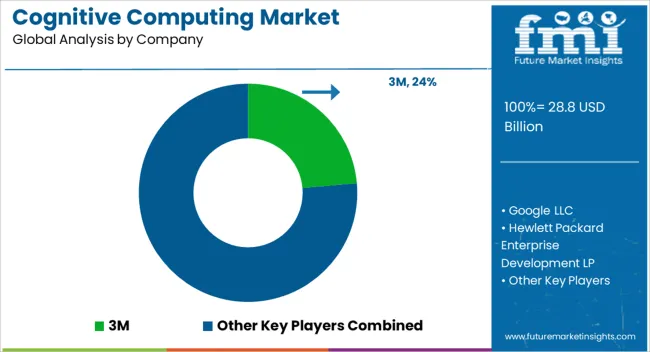
3M, Google LLC, Hewlett Packard Enterprise Development LP, International Business Machines Corporation, Microsoft Corporation, Nuance Communications Inc., Oracle Corporation, SAP SE, SAS Institute Inc., and Tibco Software Inc., among others, are the top companies in the global cognitive computing market.
With a sizable cognitive computing market share, these main firms are concentrating on growing their consumer base in new countries. These businesses are making use of strategic collaboration initiatives to grow their market share and profits.
Mid-size and smaller businesses, on the other hand, are expanding their market presence by gaining new contracts and entering new markets, thanks to technical developments and product innovations.
Market Developments
The global cognitive computing market is estimated to be valued at USD 28.8 billion in 2025.
The market size for the cognitive computing market is projected to reach USD 270.7 billion by 2035.
The cognitive computing market is expected to grow at a 25.1% CAGR between 2025 and 2035.
The key product types in cognitive computing market are on-premise cognitive computing and cloud cognitive computing.
In terms of application, diagnostic apis segment to command 42.7% share in the cognitive computing market in 2025.






Our Research Products

The "Full Research Suite" delivers actionable market intel, deep dives on markets or technologies, so clients act faster, cut risk, and unlock growth.

The Leaderboard benchmarks and ranks top vendors, classifying them as Established Leaders, Leading Challengers, or Disruptors & Challengers.

Locates where complements amplify value and substitutes erode it, forecasting net impact by horizon

We deliver granular, decision-grade intel: market sizing, 5-year forecasts, pricing, adoption, usage, revenue, and operational KPIs—plus competitor tracking, regulation, and value chains—across 60 countries broadly.

Spot the shifts before they hit your P&L. We track inflection points, adoption curves, pricing moves, and ecosystem plays to show where demand is heading, why it is changing, and what to do next across high-growth markets and disruptive tech

Real-time reads of user behavior. We track shifting priorities, perceptions of today’s and next-gen services, and provider experience, then pace how fast tech moves from trial to adoption, blending buyer, consumer, and channel inputs with social signals (#WhySwitch, #UX).

Partner with our analyst team to build a custom report designed around your business priorities. From analysing market trends to assessing competitors or crafting bespoke datasets, we tailor insights to your needs.
Supplier Intelligence
Discovery & Profiling
Capacity & Footprint
Performance & Risk
Compliance & Governance
Commercial Readiness
Who Supplies Whom
Scorecards & Shortlists
Playbooks & Docs
Category Intelligence
Definition & Scope
Demand & Use Cases
Cost Drivers
Market Structure
Supply Chain Map
Trade & Policy
Operating Norms
Deliverables
Buyer Intelligence
Account Basics
Spend & Scope
Procurement Model
Vendor Requirements
Terms & Policies
Entry Strategy
Pain Points & Triggers
Outputs
Pricing Analysis
Benchmarks
Trends
Should-Cost
Indexation
Landed Cost
Commercial Terms
Deliverables
Brand Analysis
Positioning & Value Prop
Share & Presence
Customer Evidence
Go-to-Market
Digital & Reputation
Compliance & Trust
KPIs & Gaps
Outputs
Full Research Suite comprises of:
Market outlook & trends analysis
Interviews & case studies
Strategic recommendations
Vendor profiles & capabilities analysis
5-year forecasts
8 regions and 60+ country-level data splits
Market segment data splits
12 months of continuous data updates
DELIVERED AS:
PDF EXCEL ONLINE
Cognitive Supply Chain Market Forecast Outlook 2025 to 2035
Cognitive Impairment Biomarkers Market Size and Share Forecast Outlook 2025 to 2035
Cognitive Electronic Warfare Market Size and Share Forecast Outlook 2025 to 2035
Cognitive Agents Market Size and Share Forecast Outlook 2025 to 2035
Cognitive Network Market Size and Share Forecast Outlook 2025 to 2035
Cognitive Analytics Market Size and Share Forecast Outlook 2025 to 2035
Cognitive Diagnostics Market Analysis & Forecast by Diagnosis, Indication, End User and Region through 2035
Cognitive health supplements market analysis by product type, form, sales channel, functionality, and by region – Growth, trends, and Forecast from 2025 to 2035
Cognitive Neuroscience Market Overview – Trends & Research Insights 2024-2034
Cognitive Assessment and Training Market Report – Trends & Growth Forecast 2024-2034
Cognitive Data Management Market
Cognitive Security Market
Cognitive Systems Spending Market Report – Growth & Forecast 2016-2026
Pet Cognitive Supplement Market Size and Share Forecast Outlook 2025 to 2035
Fog Computing Market
Brain Computing Interfaces Market Size and Share Forecast Outlook 2025 to 2035
Swarm Computing Market Size and Share Forecast Outlook 2025 to 2035
Cloud Computing Market Size and Share Forecast Outlook 2025 to 2035
Visual Computing Market Size and Share Forecast Outlook 2025 to 2035
Mobile Computing Devices Market Insights – Growth & Forecast 2023-2033

Thank you!
You will receive an email from our Business Development Manager. Please be sure to check your SPAM/JUNK folder too.
Chat With
MaRIA